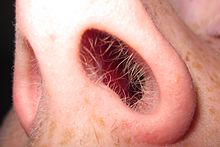Nose hair
Nose hairs ( Latin Vibrissae ) are rigid hairs in the area of the nasal entrance and serve as an air filter . They can be several millimeters long and are directed towards the nostril.
function
The air we breathe contains dirt particles such as dust or sand, which can damage the airways. These can be partially stopped by the hairs of the nose. They can also keep insects from crawling in. However, larger particles immediately trigger a sneeze reflex that cleans the nose and smaller particles - especially fine dust - can hardly be stopped. These are bound by the surface of the nose itself:
The most important filter mechanism of the nose is the nasal mucous membrane , which secretes secretions in order to be able to bind light foreign bodies better. This is then transported to the back of the nasopharynx via the 5 to 10 µm long cilia and either coughed up or swallowed.
The actual protective effect of the nasal hairs in relation to particles entering the lungs is therefore very low - also because a large part of the air we breathe is absorbed through the mouth.
distance
In many cultures, nose hair is considered undesirable and long hair protruding from the nose is considered neglected. Therefore, men in particular remove hair that is perceived as annoying. In Germany, 1/3 of people regularly remove or shorten their nose hair.
According to a doctor's recommendation, nose hairs that appear too long can be cut off without hesitation. But they shouldn't be plucked. Not only is this more painful, it is also associated with health risks. For example, hair that grows back can occasionally grow into the tissue and cause inflammation. Above all, the hair follicles can become inflamed and boils can form because bacteria can penetrate the now open canal. According to a study from the USA, even fatal infections are said to be the result. The veins emanating from the nose lead in close proximity to vessels that come from the brain. Bacteria are said to spread in this way and lead to meningitis or brain abscesses , for example. However, due to the small number of cases, this type of infection is rather unlikely. Bacteria that penetrate the bloodstream are mainly washed away by the brain and are therefore no more dangerous than the germs that penetrate through other parts of the body. It is true that germs that are dangerous for the body exist in the nose as well as in the mouth. Therefore, an injury to the nasal and oral mucosa is potentially dangerous.
As an alternative to plucking, there are electric nasal hair trimmers , the use of which is intended to prevent such injuries. If their blades are dull, however, there is also the risk of tearing hair out and thus taking the same risks as with plucking. With sharp blades and improper use, there is again the risk of damaging the sensitive mucous membrane and opening a particularly large entrance gate for bacteria, as with the classic trimming of the nose hair with scissors. The recommendations as to whether it is better to cut electrically or with scissors are therefore inconsistent.
In order to avoid any inflammation, both the nasal mucosa and the instruments are disinfected beforehand in professional nose hair removal from barbers and in the case of nose operations in clinics. This happens u. a. with small disposable alcohol swabs.
Individual evidence
- ^ Johannes W. Rohen, Elke Lütjen-Drecoll: Functional anatomy of humans: textbook of macroscopic anatomy according to functional aspects. 11th edition. Schattauer Verlag, 2005, ISBN 3-7945-2440-3 , p. 177.
- ↑ Gunda Windmüller: Beauty: That's why you shouldn't remove your nose hair. In: welt.de . November 24, 2016. Retrieved February 27, 2017 .
- ↑ Device for removing nasal hairs - Document DE202007010212U1 . patent-de.com, December 13, 2007; Retrieved May 22, 2012.

